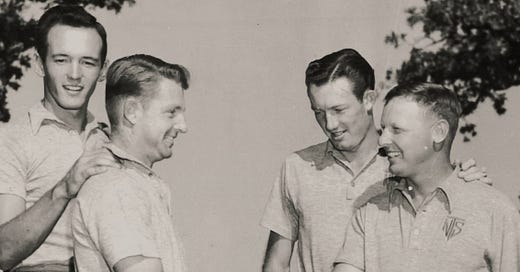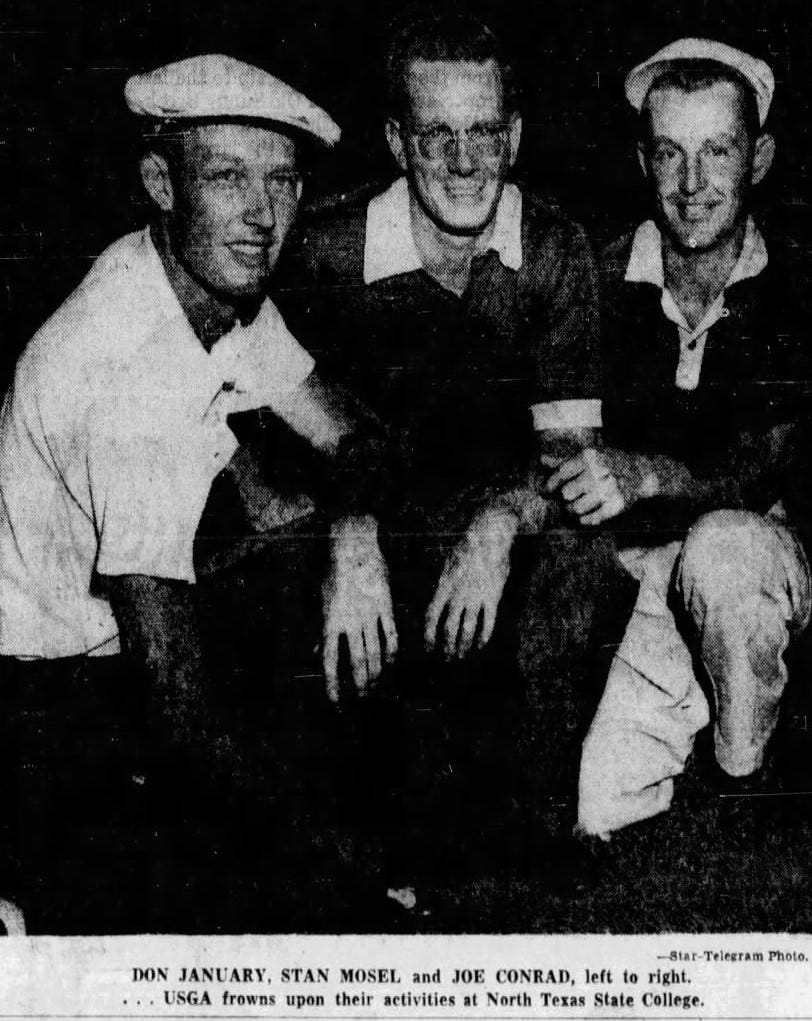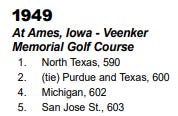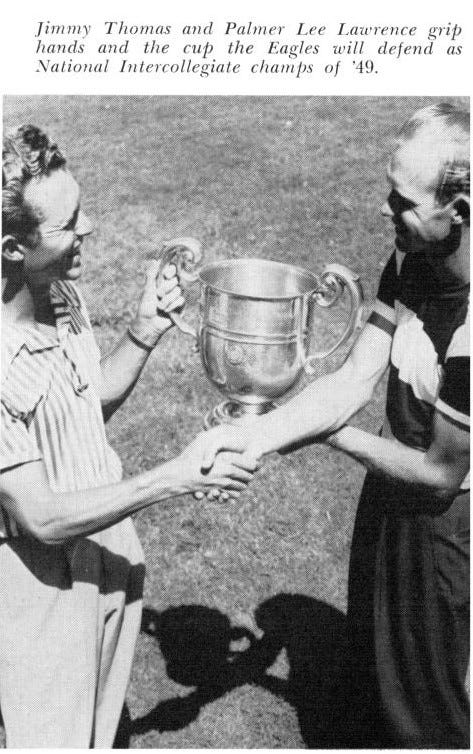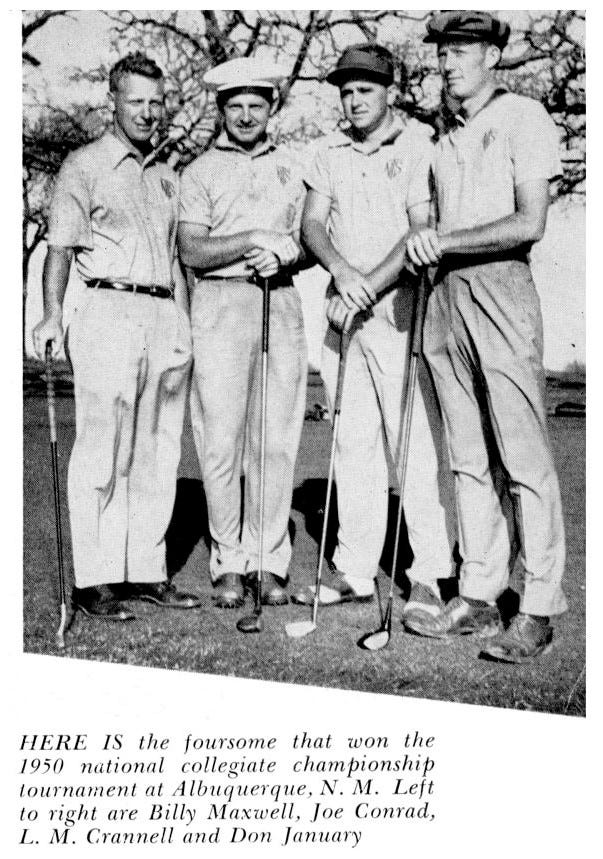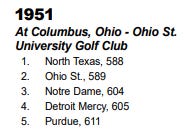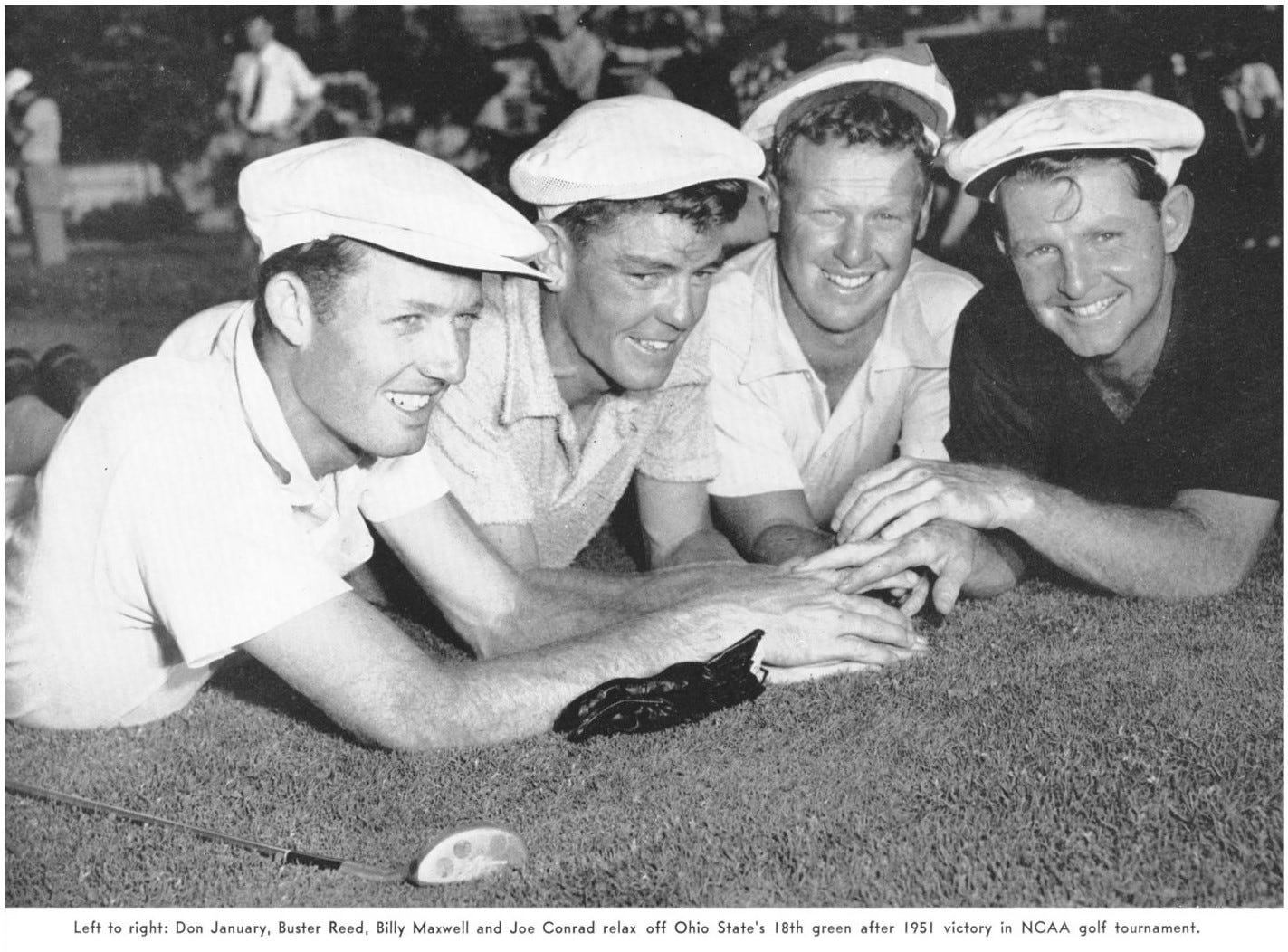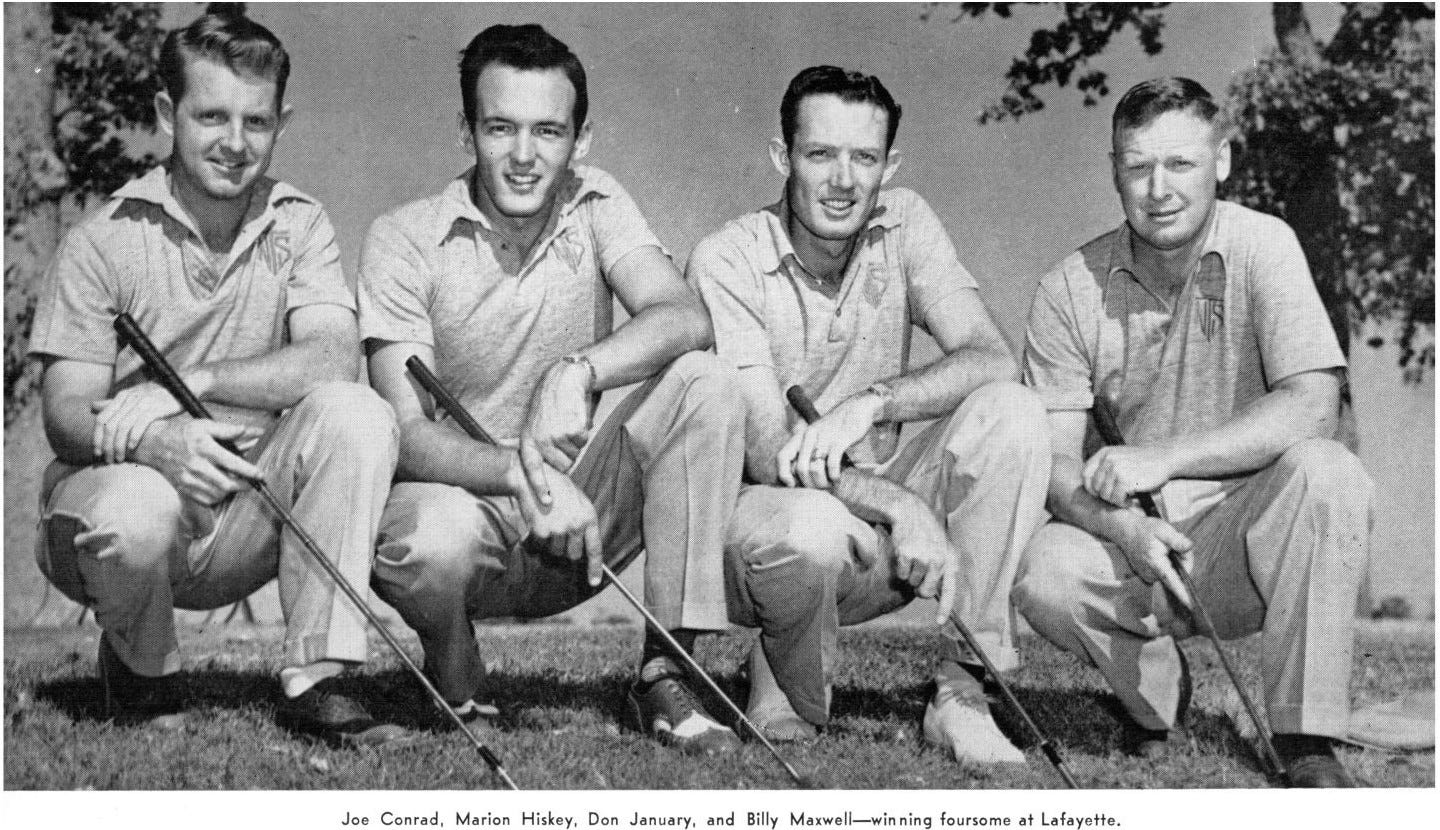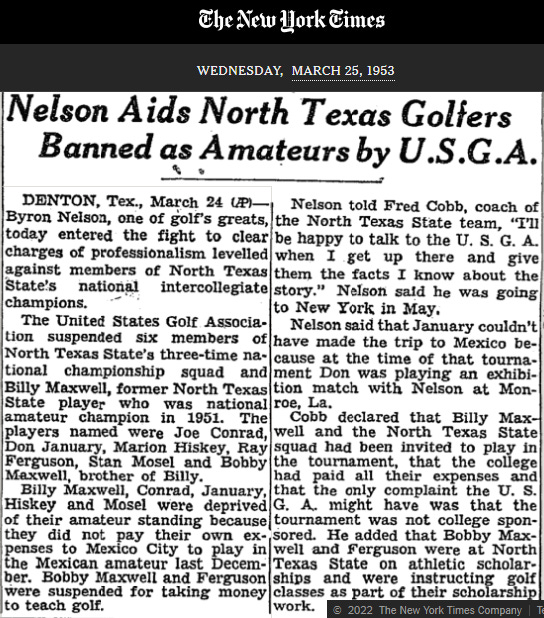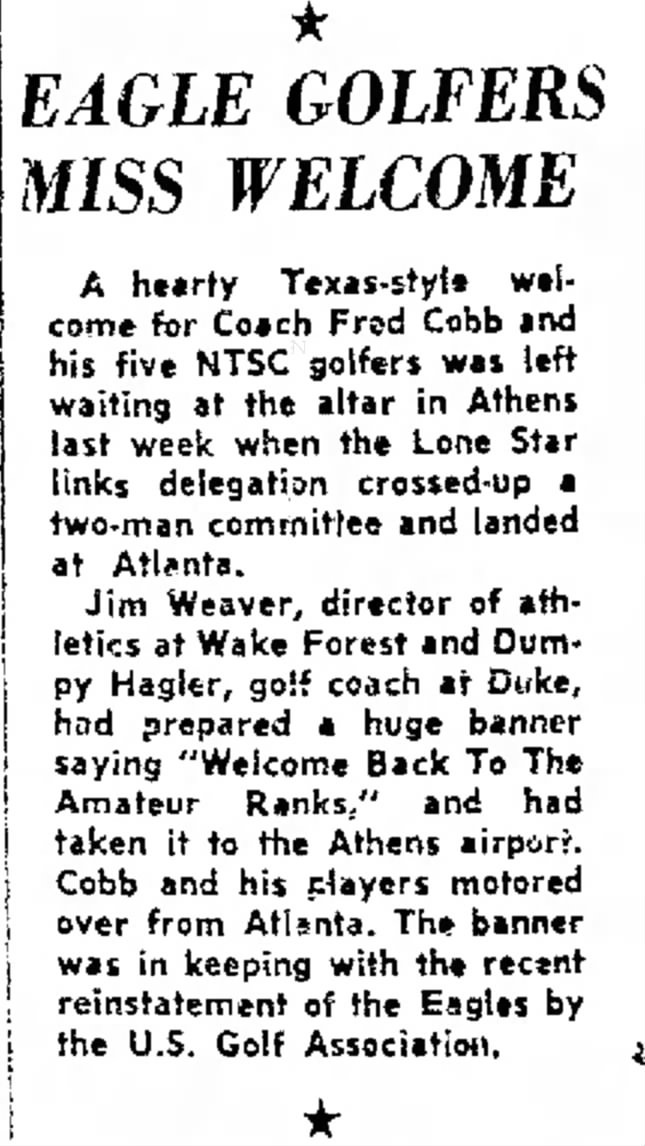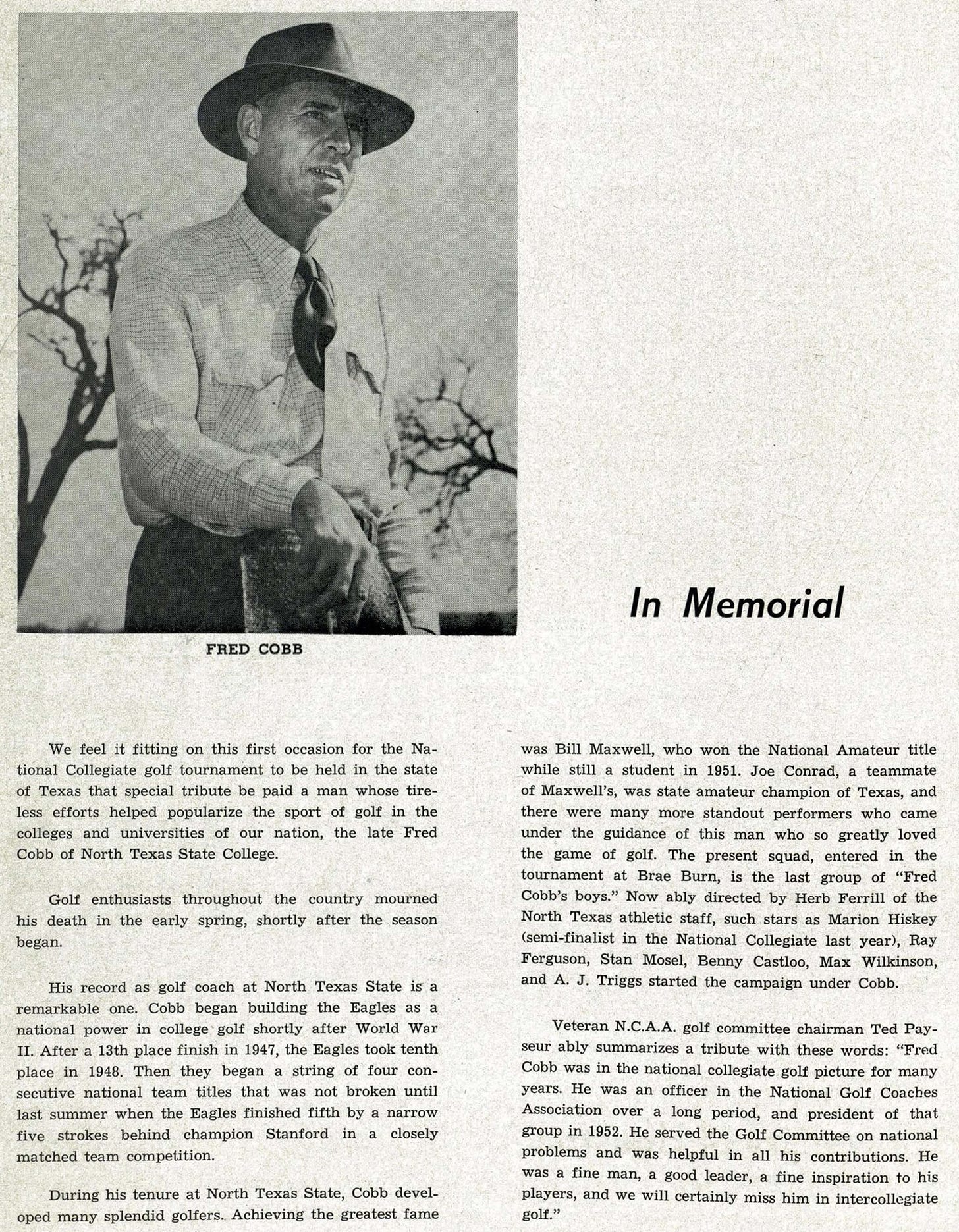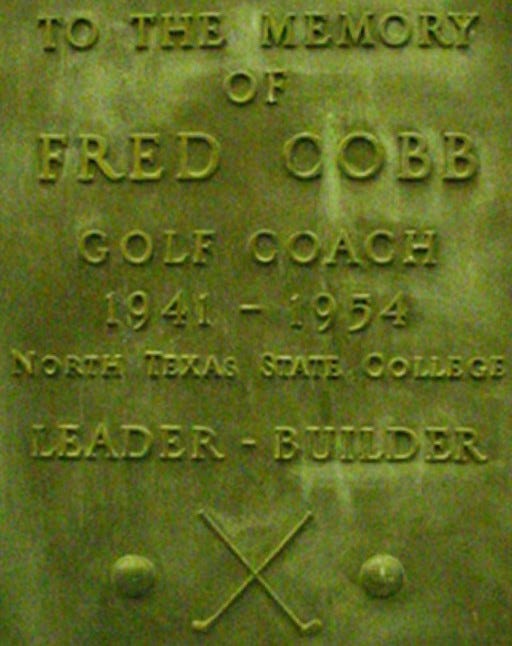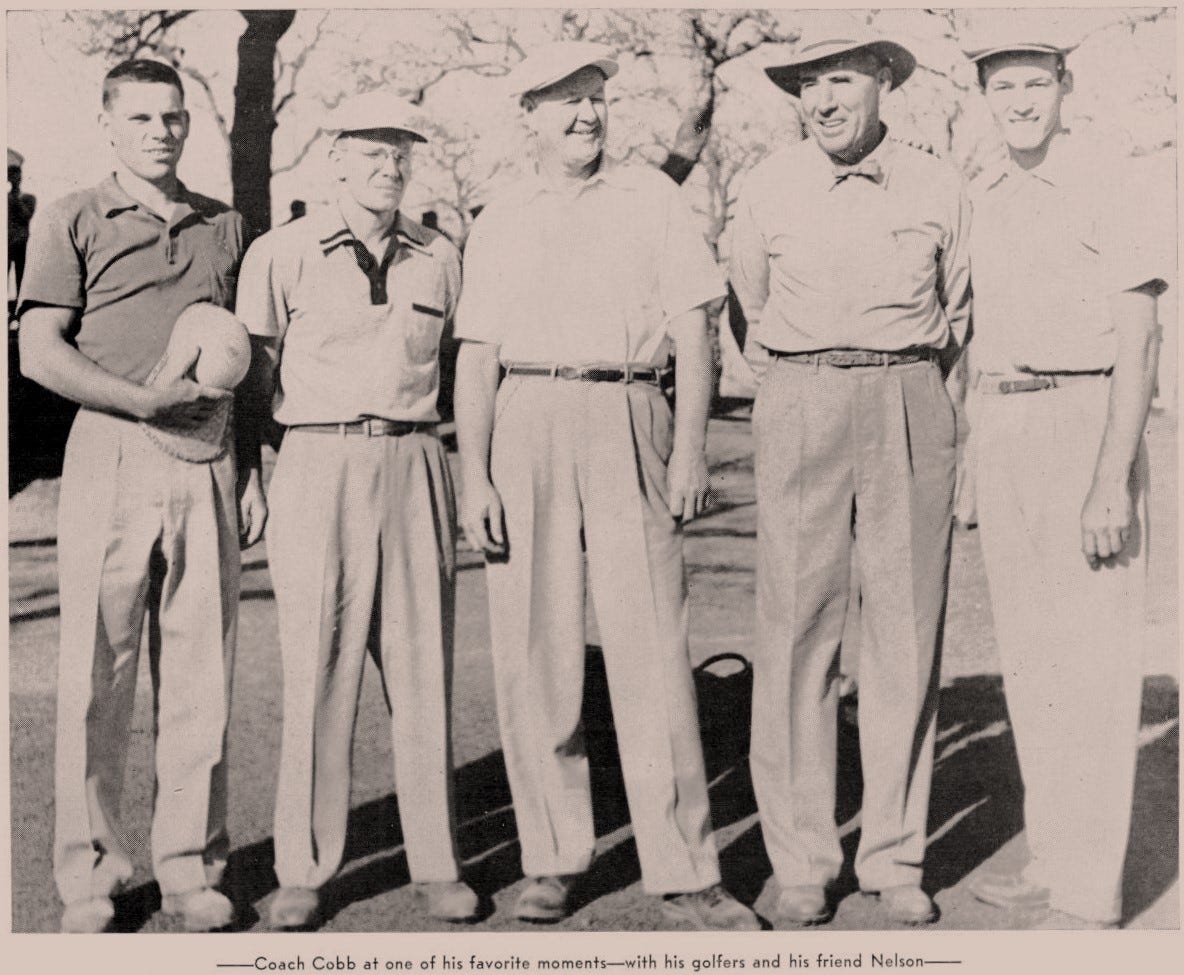1953 NORTH TEXAS STATE: A BRIEF USGA BAN INTERRUPTS A DYNASTY
If you have ever perused the NCAA men’s golf record book or watched the national championship telecast, you have have seen a string of wins by “North Texas” to begin the 1950s. It’s easy to have your eyes glide past those entries as they drift down the list to see a long string of “Houston”s interspersed with other great golf schools. If you thought about it anymore after that, you might marvel at how, 70 years ago, things must have been different. It was a different time, but what if I told you it wasn’t that different? What if I told you that the North Texas State dynasty was far more interesting than you might think? That it went on for longer than a glance down the list of winners might suggest, and survived a brief USGA ban of most of their starters and even the death of their Hall of Fame coach. What if I told you that a small college from Denton was once THE golf powerhouse of Texas?
MAIN CHARACTERS
There are many people mentioned throughout, so here are some of the main characters (in alphabetical order) to hopefully provide better context:
*NOTE: underlined text provides a link to references or sites with more information
Don January - North Texas golfer [on the team 1950-1953] who went on to have a successful pro golf career with double-digit wins including the 1967 PGA Championship
Fred Cobb - Hall of Fame coach of the North Texas State program that became a golf powerhouse in the late 1940 - early 1950s
Joe Conrad - North Texas golfer [1950-1953] who enjoyed a successful amateur career after college including playing on the 1955 Walker Cup and then winning the (British) Amateur Championship a few weeks later
Ray Ferguson - North Texas golfer [1953-1956] who enjoyed a long career as the New Jersey Country Club pro
Marion Hiskey - North Texas golfer [1952-1954] who was poised to join his teammates in becoming a successful pro golfer when he was tragically killed in an Air Force training flight in 1956
Billy Maxwell - North Texas golfer [1950-1952] who had an incredible amateur and pro career which included winning the 1951 US Am and playing on the 1963 Ryder Cup
Bobby Maxwell - North Texas golfer [1950-1953], Billy’s twin; although his playing career wasn’t as successful as his brother’s, he was a highly skilled golf pro and instructor
Stan Mosel - North Texas golfer [1952-1954] who became a fixture in USGA, MGA, and other high profile golf events which eventually earned him induction in the New Jersey PGA Hall of Fame
NORTH TEXAS STATE DYNASTY [1949-52]
BEFORE
Fred Cobb arrived at North Texas State Teachers College in 1940, joining the football team as an assistant coach. That same year, he picked up coaching the golf team. After WWII, college golf began a major boom across the United State. Coach Cobb became focused on developing golf into a major sport at NTSC, which started with the creation of a 9-hole course near Highland Park. An extremely nice 84,000 square-foot Golf Club House was built and opened in 1947 with Byron Nelson in attendance for the dedication ceremony.
That same year, NTSC sent its first golf team to the NCAA championship, held at the University of Michigan’s course. They placed a respectable 13th (20 shots behind champion LSU). The next year the team traveled to Stanford where they improved to 10th place (32 shots behind San Jose State). While Coach Cobb’s squad was clearly ready to compete, there was little to suggest that the small college from Denton, Texas was about to embark on one of the most remarkable championship runs since Princeton 20 years before.
1949 CHAMPIONSHIP
One of the first major tests for the 1949 NTSC squad was the Southern Intercollegiate held in Athens, GA. They finished well, placing 5th behind strong teams like Miami, Duke, Georgia Tech, and Georgia. Several players made the individual match play portion, Gene Towry making it all the way to the quarterfinals. Though they continued to play well leading up to the NCAA championship in late June - undefeated in 11 matches and winning 3 tournaments - nobody thought much about Coach Cobb’s team when they arrived at Iowa State’s home course amidst a field that included 240 players.
The first round ended prematurely due to bad weather, leaving 75 players still needing to finish holes the next morning, but everyone knew about North Texas as they held a 6-shot lead over the reigning champ San Jose State. While most of the eyes were on the sensational battle for medalist honors between Wake Forest sensation Arnold Palmer and Big Ten co-champion Fred Wampler of Purdue, NTSC did the unthinkable by actually improving their scores the second round to take the team title by 10 shots over Purdue. It wasn’t the University of Texas, powerhouse of the Southwestern Conference, but rather North Texas State College which became the first team champion from the state of Texas.
When asked by a reporter for the Denton Record Chronicle what the biggest thrill of the tournament was, team captain Palmer Lawrence replied, “Showing the ‘big’ boys what North Texas State can do.”
You can read more about the championship here as a part of our Men’s Championship series:
1950 CHAMPIONSHIP
Although they lost several senior to graduation, North Texas returned to action the following Spring with several talented young players including the Maxwell twins - Billy and Bobby - from Odessa, Texas. Right away, NTSC announced themselves as perhaps and even stronger team than last year by placing 2nd in the Southern Intercollegiate behind Wake Forest. The Demon Deacons were led by Arnold Palmer, individual champ, and North Texas’s Billy Maxwell and Don January finished 3rd and 4th respectively, just behind reigning NCAA champ Harvie Ward [UNC]. Among their many other strong showings throughout the Spring, NTSC also took home the Gulf Coast conference title, signaling they were ready for another run at the NCAA title.
NTSC arrived in Albuquerque at New Mexico’s home course with the Maxwell Cup in hand, intent on proving the previous year was no fluke. After the first round, they were in the familiar spot atop the leaderboard, but this time holding a slim one-stroke lead over Purdue. Despite the fact that Purdue would improve in the second round to best the previous 36-hole team record (579) by two strokes, North Texas again left with the Maxwell Cup by dusting the old record with a team total of 573. Also repeating was Arnold Palmer who again took home medalist honors, but once again he was upstaged in the individual match play portion and prevented from taking home the coveted Chick Evans Bowl.
With the victory, little NTSC became the first team to repeat as champions since Coach Eddie Twigg’s vaunted Stanford teams won the last IGA championship in 1938 and the first NCAA championship in 1939.
1951 CHAMPIONSHIP
Coach Cobb’s two-time NCAA championship team returned in the Spring of 1951 still relatively young and with room to improve. One of the biggest tests continued to be the Southern Intercollegiate, and this time NTSC came out on top. Not only did Eagles win the team championship, but Billy Maxwell took home the individual title after shaving two strokes off Arnold Palmer’s previous 72-hole record score of 280. Teammates Buster Reed and Joe Conrad finished 3rd and 4th respectively.
By the time NTSC had reached Ohio State’s vaunted Scarlet Course in late June for the NCAA championship, they were considered the favorite to once again take the Maxwell Cup; but first they would have to contend with the Big Ten champion Ohio State team playing on their home course. North Texas raced out to an early lead with a three-stroke cushion over Ohio State, UNC, and Detroit after the first round. A strong wind blew over the course in the second round, sending scores soaring and blowing open the doors to the team championship race. As Ohio State sat in the clubhouse (or more accurately, greenside of number 18), NTSC’s Don January had a 3-foot par putt on the final green to secure a one shot victory. As reported in the New York Times the next day: “He dropped it with dispatch.”
Once might be a fluke and twice might be a run, but winning three times put NTSC in rarified air. Since the NCAA had taken over running the championship in 1939, only Stanford and LSU had won three total championships. Taking into account the 42 championships held before the NCAA became involved only added Yale, Harvard, and Princeton to that list. To add to that, only the latter three teams had won 3 championships in a row at any point in the championship history, the most recent being Yale’s 3-peat 1931-33.
1952 CHAMPIONSHIP
When the North Texas players got together in the Spring of 1952, Billy Maxwell brought with him the Havemeyer trophy he won the previous Fall by defeating (among others) Harvie Ward and future New York State Supreme Court Justice Joe Gagliardi for the title of U.S. Amateur champion.
The 1952 season was interesting for multiple reasons. First, a new tournament was created in Laredo, Texas, called the Border Olympics. Coach Cobb’s team blitzed through that event and most of the others for the rest of the season. Once again, the Eagles took home the Southern Intercollegiate title as Billy Maxwell won the individual trophy. Shortly before the NCAA championship in late June, NTSC participated in the first ever National Association of Intercollegiate Athletics (NAIA) golf championship which they won easily as a team; Marion Hiskey taking the individual title followed closely by teammates Don January and Buster Reed who tied for 2nd. It’s safe to say they were ready for the NCAA championship.
Rolling into Purdue’s home turf as the three-time defending champs must have felt a bit like entering the lion’s den holding a spear topped with a lion’s tooth given how NTSC had “stolen” the title that could have possibly been Purdue’s the past several seasons. Much like before, however, the Eagles tamed the other beasts (mascots weren’t a huge thing but why let that get in the way of a good analogy?) and stood victorious over an impressive and familiar leaderboard that included the Big Ten champion Michigan team, Purdue, Texas, and Oklahoma State.
With their fourth championship in as many years, North Texas had officially become a dynasty. Only Yale and Princeton had won 4 titles in a row, with the most recent occurrence being Princeton’s 4-peat 1927-30. It seemed like the party was never going to stop.
THE USGA BAN HAMMER HITS [1953]
The Spring of 1953 started like normal. By the middle of March, NTSC had won matches and even the second annual Border Olympics. Two weeks later, though, everything changed.
BANNED
The letters sent to 6 North Texas State golfers might have made great Aprils Fools jokes had they arrived a week later. Unfortunately for Ray Ferguson, Marion Hiskey, Don January, Stan Mosel, Joe Conrad, and Bobby Maxwell, the USGA letterhead was real and so too was the news that they had officially been stripped of their golf amateur status effective immediately. The first four were current members of the team while Conrad and Maxwell had already left school.
So what did they do and what did losing their amateur status actually mean? Usually matters like these were expressed with a private letter explaining the details of the offense(s) worthy of a banning from USGA governed events for a minimum of 2 years. This meant that all of them would be unable to compete in some of the highest profile amateur events such as the US Amateur. Because of the continued ties between the USGA and the NCAA, there appeared to be some confusion over whether this would also prevent the current players from competing in the national championship. Thus the four-time defending champ NTSC was in real danger of having none of their starters for the 1954 or even 1955 NCAA championships.
PUBLIC DEFENSE
Given the high profile of the players in question, details of the banning naturally leaked out quickly. Since the USGA did not normally comment publicly on these matters, that left the court of public opinion to weigh in on things. One of those people vocally on the side of the NTSC players was none other than the great Byron Nelson who had a ranch in the area and had been a supporter of the program for many years.
Because things had been made public, the USGA no longer felt obligated to continue with their normal policy of privacy, and released more details on their findings that led to the bans. As mentioned in the New York Times story above, most of the players were cited as having received money from the school to compete in a non-collegiate amateur event. It turns out, however, it wasn’t just a single occurrence the previous year, but rather upwards of a half dozen spanning back to 1950. Likewise, the notion that players were simply helping their coach teach golf to other students on a part-time basis was expanded to say they were essentially being compensated in the form of living expenses and scholarships. An additional insinuation that wasn’t spelled out in the USGA statements but was addressed by Coach Cobb himself was that the players were given scholarships based solely on their ability to play golf. While the NCAA did have rules regarding sports scholarships - known as the “Sanity Code” - it was actually the USGA which was more restrictive on the matter of golfers receiving scholarships, and Coach Cobb’s recruitment over the past several years became indirectly scrutinized.
Relevant excerpts from the 1953 USGA Rules of Golf
Rule 2-3: Instruction
Receiving compensation for giving instruction in playing golf, either orally, in writing, by pictures or by other demonstrations, to either individuals or groups.
*EXCEPTION: Faculty members of recognized educational institutions who are not primarily teachers of physical training or athletic sports and whose golf instruction is given to students and is incidental to their academic duties.
Rule 2-9: Expenses
Accepting expenses, in money or otherwise, in connection with a golf competition or exhibition (except from one on whom the player is normally dependent).
*EXCEPTIONS: A reasonable amount of expenses may be accepted in the following specific instances only:
As a representative of the United States Golf Association...
As a qualified contestant in the USGA Amateur Public Links Championship...
As a representative of a recognized educational institution or of a military service in (1) team events or (2) other events which are limited to representatives of recognized educational institutions or of military services, respectively. In each case, expenses may be accepted from only the authority represented
Rule 2-10: Proselyting and Athletic Scholarships
“Because of golf skill or golf reputation, accepting any consideration as an inducement to be a student in an educational institution. However, a student may accept a scholarship approved by a regular authority of the institution awarding all scholarships.
REVERSAL
After a month of tense arguments and explanations that leaked out into various newspapers, the USGA officially announced the reinstatement of the amateur status of 5 NTSC players. In the public release, the USGA again laid out their case against each of the players and cited their individual applications for reinstatement in which the players apparently acknowledged violating one or more of the rules (capitalized in the announcement as “Rules”). The one player whose application the USGA apparently didn’t receive was Bobby Maxwell, which confused Coach Cobb who stated all of them were sent at the same time. It was also announced that Bobby’s twin brother Billy, who was graduated and now serving in the Army, had also had his amateur status suspended for violating the same rules. For those players reinstated, the USGA considered the short one month ban an incredible mercy:
“Normally, an applicant is not eligible for reinstatement until a probationary period of two years has elapsed from the date of his last violation of the Rules. In the present cases, the USGA Executive Committee waived the balance of the probationary period because evidence indicated that the student golfers had inadvertently conformed to routines and practices at North Texas State College which were at variance with the Rules of Amateur Status. These practices included the payment of expenses to non-college events, beginning in 1950, and compensation of students for teaching golf, beginning in 1947, according to information given to the USGA”
Though strongly worded and stated with authority, an interesting discussion arose from this release. For one, the USGA acknowledged that other schools were said to be doing the same things, to which they stated that if they received definitive proof then they would apply the same ruling to the others. Secondly, they conceded that the question had been raised about the USGA’s ability to enforce any kind of punitive ban against college golfers since the NCAA rules were so much more loosely worded and there was only a tentative agreement that being considered an amateur by the USGA’s definition was needed to compete under the NCAA. In both cases, the USGA relied on the notion of golf being a gentlemanly game where honor is derived from following the spirit (if not the letter) of the [R]ules, and each man was to be taken at his word regarding his amateur status under those [R]ules. You can roll your eyes at the loftiness of this sentiment, however it still resides in today’s game even with the loosening of the term “amateur” in recent years.
“Golf has thrived on this code of sportsmanship. In the long run, young players will be better off for developing their own self controls and a true sense of honesty than if they are obliged to do something only because of outside compulsion. We feel that these principles were at the heart of the present case. We hope that the young men concerned may have learned something not only from the educational institution which they attend but also from the game to which they devote much interest. Perhaps golf has contributed something to their development as persons. We hope that it has.”
USGA President Totten P. Heffelfinger
RETURNING TO COLLEGIATE PLAY
With the issue of their amateur status settled, the NTSC team was able to fly to the Southern Intercollegiate in late April. Perhaps feeling they had something to prove, NTSC breezed to a nine stroke team victory over LSU in the first 36 holes. LSU’s Eddie Merrins sank a 15” putt on the 72nd hole to barely edge out Stan Mosel.
Expecting the team to fly back home after the tournament, Wake Forest AD Jim Weaver and Duke’s Coach “Dumpy” Hagler made up a humorous sign at the Atlanta airport for the NTSC players, “Welcome Back to the Amateur Ranks.” Unfortunately, the team decided to drive back to Texas and missed the banner.
1953 CHAMPIONSHIP
Despite everything going on that made the 1953 regular season anything but regular, NTSC arrived at the NCAA championship in Colorado as the perennial favorites. One thing you may notice from the newspaper clipping above is the absence of Don January and Joe Conrad from the NTSC roster. As of this writing, we have not come to fully understand why arguably NTSC’s best players were not allowed to play in the championship apart from the mention in a few local papers to the fact that the pair had already graduated at that point; clearly there was no scandal involved yet there had been several instances of players competing in the late-June championship after they had technically graduated. Regardless of the reason, NTSC clearly missed January and Conrad who were busy playing in (and in Conrad’s case, winning) the Trans-Miss Amateur. Despite 4 NTSC players qualifying for individual match play (65 players) - Mosel, Hiskey, Billy Hill, and Benny Castloo - they finished 5 shots (and 4 places) behind Stanford.
AFTERWARDS
TRAGEDY
The championship streak had ended but there was little reason to think NTSC wouldn’t continue to be a contender in 1954 and beyond. Again, however, the team was upended in late March following the annual Border Olympics. The news of Coach Cobb’s untimely death due to a heart attack at the age of 55 shocked the college golf world.
1954 CHAMPIONSHIP
You might think things would go in one of two directions: either the NTSC golf program would go into a tailspin or win the whole thing. Sadly (or not, depending on your proximity to SMU) the feel-good sports movie ending wouldn’t come.
Playing in the final group, SMU’s Stewart Carrell was the only man left on the course who could affect the team championship. His tee shot on one of the closing holes found the water, giving NTSC hope, but Carrell made a remarkable recovery shot to bogey the hole and lead SMU to a one shot victory. Looking back, Stan Mosel’s double-bogey 5 on the par-3 16th hole after finding the marsh just short of the green may have been the ultimate decider. In any case, given the circumstances, NTSC’s runner-up finish showed they were still going strong even without the players (and coach) who were most responsible for their four championships. After all, they had only lost to 5 teams in the last 2 years at the NCAA championships.
1955 CHAMPIONSHIP AND BEYOND
Under the leadership of new coach Herb Ferrill, NTSC (later University of North Texas) continued to be a regular presence at the NCAA championships throughout the 1950s-70s. In fact, during Coach Ferrill’s reign from 1955-83, North Texas won an incredible 16 conference championships. Despite coming tantalizingly close numerous times in the NCAA championship, they never could recapture that magic run that would gain them repossession of the Maxwell Cup. Coach Ferrill was much more than a simple “fill-in” for the legendary Coach Cobb, and both men were eventually placed among the college golf greats in the Golf Coaches Association of America Hall of Fame.
Now, when we see the North Texas entries in the record books, we remember just how incredibly special (and interesting) that run actually was.

